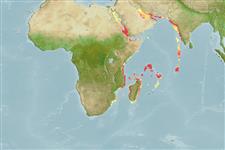Elasmobranchii (hajar och rockor) (sharks and rays) >
Myliobatiformes (Stingrays) >
Dasyatidae (Stingrays) > Urogymninae
Etymology: ambigua: Name from Latin 'ambiguus' meaning uncertain, doubtful; referring to its uncertain species-
level uniqueness, as it very closely resembles Maculabatis gerrardi from the northern
Indian Ocean and M. randalli from the nearby Persian Gulf but is more closely related to white-spotted members of the genus..
Environment: milieu / climate zone / depth range / distribution range
Ekologi
marina bentopelagisk; djupintervall 10 - 60 m (Ref. 111065). Tropical
Utbredning
Länder | FAO områden | Ekosystem | Förekomster | Point map | Utplanteringar | Faunafri
Western Indian Ocean: Red Sea to Tanzania (Zanzibar).
Size / Vikt / Age
Maturity: Lm ? range ? - ? cm
Max length : 90.0 cm WD hane/ej könsbestämd; (Ref. 111065); 84.0 cm WD (female)
Short description
Morfologi | Morfometri
This species is distinguished by the following set of characters: rhomboidal disc with its axis of greatest width well forward, snout tip to maximum disc width 37% (35-39%) DW; short preorbital snout with small apical lobe, rather obtuse, snout angle 121-127°; pectoral-fin apices are narrowly rounded, angle 86-92°; orbits are moderately small, protruding slightly; mouth relatively narrow, its width 6.2-7.0% DW; small pelvic fins, length 17-19% DW, width across base 13-14% DW; preoral snout length is 2.8-3.1 times internasal width, 19-21% DW, interorbital distance 2.0-2.2 times orbit length, prenasal length 2.2-2.4 times internasal width; subcircular tail with longitudinal ventral groove is behind caudal sting; tail weakly depressed posteriorly, with longitudinal lateral ridge on each side in subadults; an enlarged, seed-shaped, suprascapular thorn usually followed by up to 5 much smaller primary denticles in adults (suprascapular thorn may be preceded by a few much smaller primary denticles in early juveniles); a band of secondary denticles suboval (in subadults), very broad (its width across scapulocoracoid much narrower than its width at spiracles), with sharply-defined lateral margins, broad and semi-truncate near tail base; band fully developed and covering entire dorsal surface of tail by 49 cm DW; colour of dorsal surface mainly uniformly brownish, disc margin paler brown dorsally and ventral disc uniformly whitish, not obviously black edged; in subadults, darker dorsal surface of tail is sharply demarcated from slightly paler ventral surface (median furrow dark and contrasted with skin adjacent); in juveniles, the dorsal post-sting tail has conspicuous, alternating, black-and-white saddles that persist nearly to tail tip, ventral tail uniformly greyish; pectoral-fin radials 130-135; total vertebral count (excluding first synarcual centra) 108-116, monospondylous centra 44-46, pre-sting diplospondylous centra 64-67 (Ref. 111065).
A typical inhabitant of soft substrata and are trawled in shallow water (Ref. 111065). Biology unknown (Ref. 114953).
Life cycle and mating behavior
Könsmognad | Reproduktion | Lek | Ägg | Fecundity | Larver
Last, P.R., S.V. Bogorodsky and T.J. Alpermann, 2016. Maculabatis ambigua sp. nov., a new whipray (Myliobatiformes: Dasyatidae) from the Western Indian Ocean. Zootaxa 4154(1):66-78. (Ref. 111065)
IUCN Red List Status (Ref. 130435)
Threat to humans
Harmless
Human uses
Ytterligare information
LänderFAO områdenEkosystemFörekomsterUtplanteringarStocksEkologiFödaFödoslagFödointagNäringsinnehåll
PopulärnamnsynonymerMetabolikPredatorerEkotoxikologiReproduktionKönsmognadLekSpawning aggregationFecundityÄggEgg development
Age/SizeTillväxtLength-weightLength-lengthLength-frequenciesMorfometriMorfologiLarverLarvdynamikRekryteringAbundansBRUVS
referenserVattenbrukVattenbruksprofilAvelslinjerGenetikElectrophoresesÄrftlighetSjukdomarBehandlingNutrientsMass conversion
MedarbetareBilderStamps, Coins Misc.LjudCiguateraHastighetSimsättGälytaOtolithsHjärnstorlekSyn
Verktyg
Special reports
Download XML
Internet-källor
Estimates based on models
Phylogenetic diversity index (Ref.
82804): PD
50 = 0.5078 [Uniqueness, from 0.5 = low to 2.0 = high].
Bayesian length-weight: a=0.01622 (0.00606 - 0.04338), b=3.00 (2.77 - 3.23), in cm total length, based on LWR estimates for this (Sub)family-body shape (Ref.
93245).
Trofisk nivå (Ref.
69278): 3.7 ±0.4 se; based on size and trophs of closest relatives
Fishing Vulnerability (Ref.
59153): Very high vulnerability (90 of 100).
